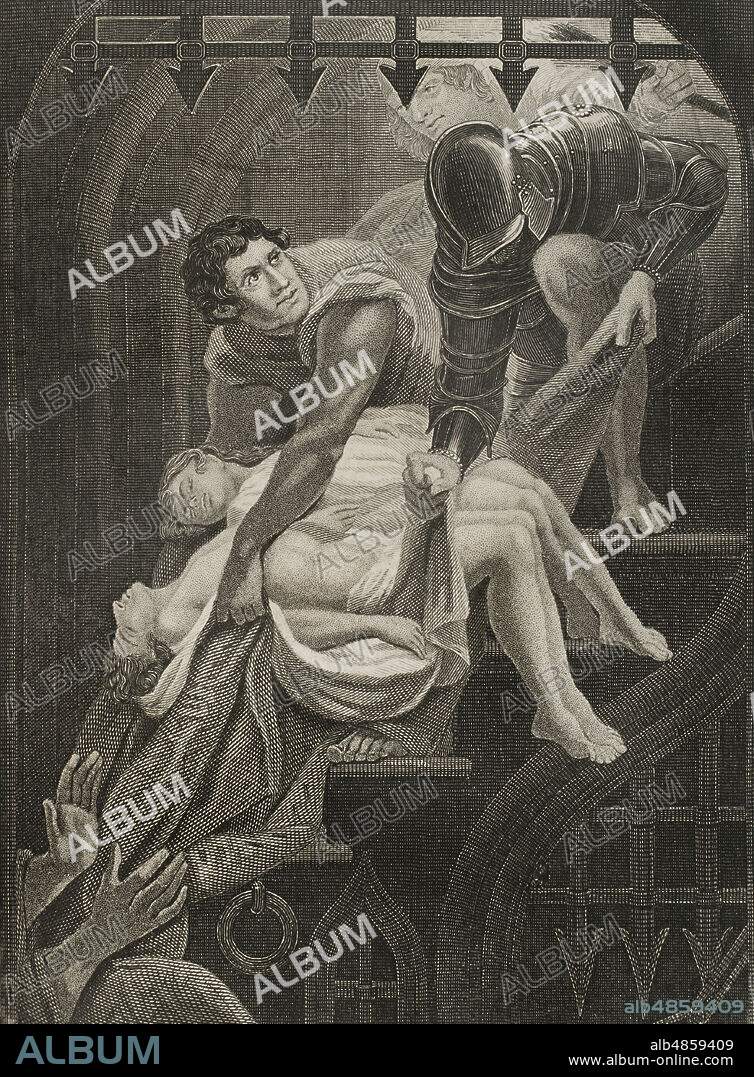alb4859409
After the death of King Edward IV of England (1442-1483), his brother Richard (1452-1485), Duke of Gloucester, took advantage of the fact of being guardian of the heirs to the throne and Lord Protector of the Realm, to imprison his nephews, Edward V (1470-1483) and his brother Richard of Shrewsbury, Duke of York (1473-1483). The princes were murdered by one of Richard's hired assassins, smothering them with a pillow while they slept. Richard had ordered Robert Brakenbury, Constable of the Tower of London, kill his two nephews, but Brakenbury refused. Richard then gave the order to Sir James Tyrrell (ca. 1455-1502), who with the help of three accomplices, named William Slater, John Digton and Forrest, executed the murder. Duke Richard proclaimed himself king in 1483, reigning as Richard III from 26 June 1483 to 22 August 1485. The corpses were buried at the foot of the staircase in the Tower of London, at shallow depths, where they were found on July 1674. The sons of Edward IV. Engraving depicting the Act IV, Scene III, from the tragedy written about 1592 by William Shakespeare (1564-1616), entitled "The Tragedy of Richard the Third". Historia de las persecuciones políticas y religiosas en Europa (History of political and religious persecutions in Europe). Volume II. Published in Barcelona, 1864.

|
Ajouter à une autre Lightbox |
|
Ajouter à une autre Lightbox |



Avez-vous déjà un compte? S'identifier
Vous n'avez pas de compte ? S'inscrire
Acheter cette image.
Sélectionnez l'usage:

Légende:
Voir la traduction automatique
After the death of King Edward IV of England (1442-1483), his brother Richard (1452-1485), Duke of Gloucester, took advantage of the fact of being guardian of the heirs to the throne and Lord Protector of the Realm, to imprison his nephews, Edward V (1470-1483) and his brother Richard of Shrewsbury, Duke of York (1473-1483). The princes were murdered by one of Richard's hired assassins, smothering them with a pillow while they slept. Richard had ordered Robert Brakenbury, Constable of the Tower of London, kill his two nephews, but Brakenbury refused. Richard then gave the order to Sir James Tyrrell (ca. 1455-1502), who with the help of three accomplices, named William Slater, John Digton and Forrest, executed the murder. Duke Richard proclaimed himself king in 1483, reigning as Richard III from 26 June 1483 to 22 August 1485. The corpses were buried at the foot of the staircase in the Tower of London, at shallow depths, where they were found on July 1674. The sons of Edward IV. Engraving depicting the Act IV, Scene III, from the tragedy written about 1592 by William Shakespeare (1564-1616), entitled "The Tragedy of Richard the Third". Historia de las persecuciones políticas y religiosas en Europa (History of political and religious persecutions in Europe). Volume II. Published in Barcelona, 1864.
Personnalités:
Emplacement:
Collection privée
Crédit:
Album / Prisma
Autorisations:
Modèle: Non - Propriété: Non
Questions sur les droits?
Questions sur les droits?
Taille de l'image:
3248 x 4413 px | 41.0 MB
Taille d'impression:
27.5 x 37.4 cm | 10.8 x 14.7 in (300 dpi)
Mots clés:
15 15E 15EME XV XVE XVEME SIECLE • 15E SIECLE • 15EME S • ANGALIS • ANGLAIS • ANGLAISE • ANGLETARRE • ANGLETERE • ANGLETERRE • ASPHIXIE • ASPHYXIE • ASSASSINÉ • ASSASSINS • CACHE • CACHETTE • CADAVRE • CAMOUFLAGE • COLLECTION PRIVÉE • COMPLICE • CORPS CADAVRES • CORPS HUMAIN • CORPS • DÉCÈS • DÉPOUILLE • EDOUARD V, ROI D'ANGLETERRE • ENFANT • ENFOUIR • ENGLAND • ENTERRER • FOURRURE • FRAVURE • FRERE • GRANDE BERTAGNE • GRANDE BRETAGNE • GRANDE-BRETAGNE • GRAVURE • HERITIER DU TRONE • HISOIRE • HISTOIRE • INGLATERRA • LONDON • LONDRES • LONDRES, VUE SUR • LONDRES, VUE • MONARCHIE • MORT CADAVRES • MORT • PEAU (ANIMAL) • PRICE • PRINCE • PRINCES • QUINZIÈME SIÈCLE • REFUGE • RICHARD OF SHREWSBURY • ROYAUME UNI • ROYAUME-UNI • SHAKESPEARE, WILLIAM • TOISON • TRAGEDIE • TUER • VUE LONDRES • XVE SIECLE
 Pinterest
Pinterest Twitter
Twitter Facebook
Facebook Copier le lien
Copier le lien Email
Email
